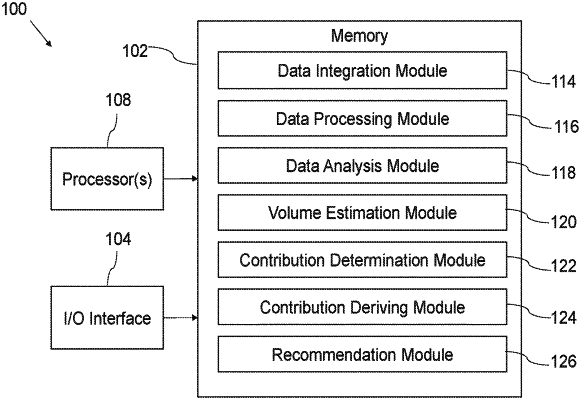| CPC G06Q 30/0202 (2013.01) [G06N 20/00 (2019.01)] | 5 Claims |

|
1. A processor-implemented method, comprising:
collecting, via one or more hardware processors, a set of transaction level historical sales volume information of a product, customer information associated with the product, and one or more predefined sales drivers of the product, wherein
the one or more predefined sales drivers are collected from one or more predefined sources,
the one or more predefined sales drivers include demography information of each store,
the demography information is information relates to a population of a trade area of each store, and
each store has a plurality of component scores that represents demographic variables in a condensed format;
integrating, via the one or more hardware processors, the collected set of transaction level historical sales volume information of the product, the collected customer information, and the collected one or more predefined sales drivers;
applying a software framework for distributed storage to store and process the integrated set of transaction level historical sales volume information, wherein
the integration and data processing occurs in a Random Access Memory (RAM) so that the data processing and the integration of different level of transaction in real time, and
the different level of transaction includes a store customer level and a corporate level;
training a machine learning model using the integrated set of transaction level historical sales volume information;
processing, via the one or more hardware processors, using the trained machine learning model, the integrated set of transaction level historical sales volume information;
generating, based on the processing, via the one or more hardware processors, one or more metrices and one or more sales driver components associated with the product, wherein the generated one or more metrices include probability distributional parameters of quantity at the store customer level and at the corporate level;
converting the demography information into a correlation matrix;
applying a principal component analysis to the converted correlation matrix, to condense specific information of the converted correlation matrix without losing a network relationship between a plurality of components of the specific information;
deriving the plurality of components from the specific information, wherein the plurality of components is derived in a network fashion;
computing, via the one or more hardware processors, a reference value for the collected one or more predefined sales drivers in an actual form of the product or in a derived component form of the product at the store customer level and the corporate level, wherein the computation of reference value is based on the one or more metrices and the derived plurality of components;
estimating, via the one or more hardware processors, a reference base volume of the product based on the computed reference value, using the trained machine learning model, wherein the estimation further comprises:
mapping historical sales volume data with the one or more pre-defined sales drivers, wherein the one or more sales drives includes a price of the product, a competitor price of the product, demographic components, weather, a space occupied by a category to which the product belongs, a number of available substitute products in assortment at the time of sale; and
determining:
a quantity of sales volume at a specific time interval as dependent variables; and
the one or more pre-defined sales drivers at the specific time interval as independent variables, wherein the specific time interval is based on a velocity of the product at which the product is sold;
training, via the one or more hardware processors, using the determined dependent variables and the determined independent variables, a specific machine learning model, wherein the specific machine learning model is a random forest at the corporate level;
capturing, via the one or more hardware processors, based on the trained specific machine learning model, sales volume variations that arise across stores due to retailer price, the competitor price, location, weather of the store, a space occupied by the product, and assortment, wherein the specific machine learning model is trained for a specific period of time, wherein the specific period of time is between seven days to thirty days;
determining, via the one or more hardware processors, sales volume contribution of the collected one or more predefined sales drivers in the actual form of the product or in the component derived form of the product based on a difference between a reference volume of a sales driver and a reference base volume;
deriving, via the one or more hardware processors, sales volume contribution of a predefined individual variable of the sales driver in the derived component form for the product, wherein the sales volume contribution by the predefined individual variable of the one or more pre-defined variables is derived based on a product of:
a factor loading of the predefined individual variable, and
sales volume due to demographic component; and
recommending, via the one or more hardware processors, one or more retail strategies in real time using the derived sales volume contribution of the predefined sales drivers for the product, wherein
the sales volume contribution by the predefined individual variable is one of a positive contribution or a negative contribution depending on an effect of predefined individual variable,
the positive contribution indicates that the predefined individual variable is contributing to a total volume of the product for a particular period, and
the negative contribution indicates that the predefined individual variable is reducing the total volume of the product for the particular period;
displaying, via the one or more hardware processors, one of the positive contribution or the negative contribution in a tabular format and a graphical representation, wherein the positive contribution is indicated in a green color and the negative contribution is indicates in a red color in the graphical representation.
|